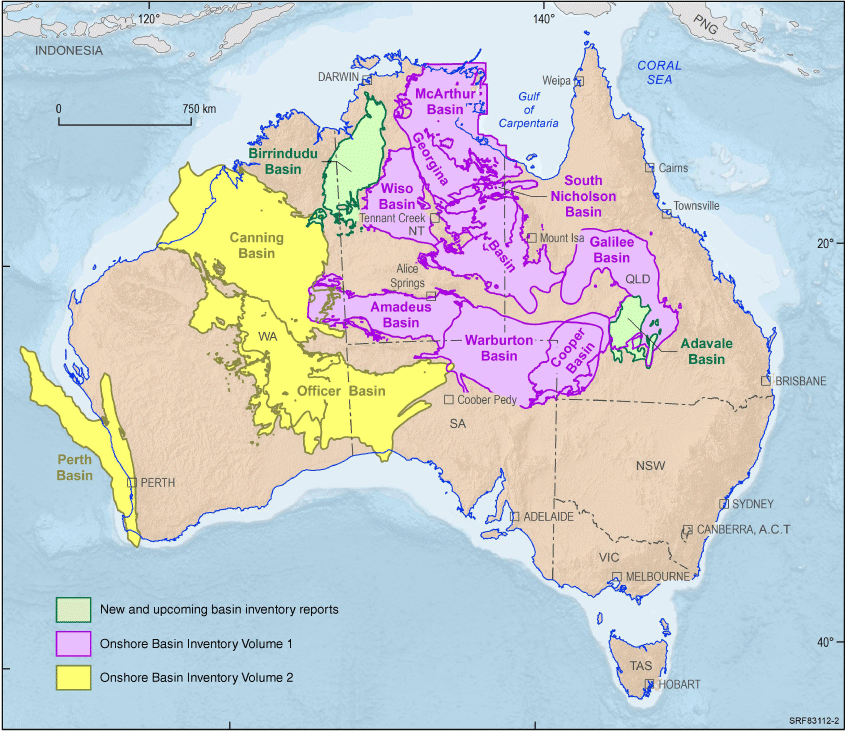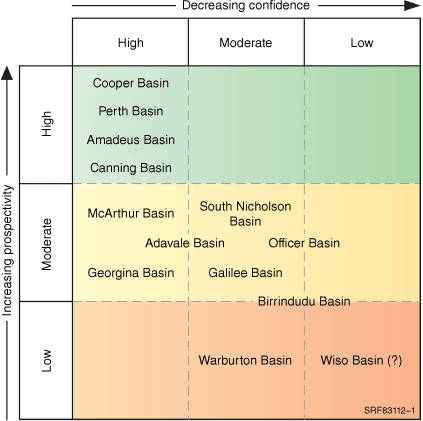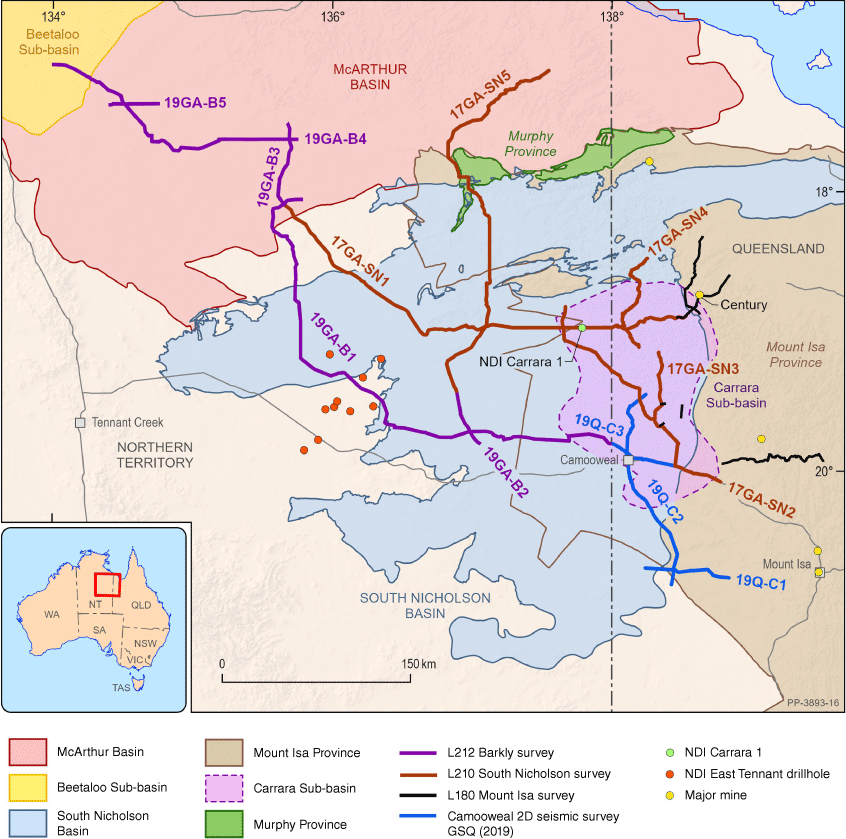Australia’s Onshore Basin Inventories – foundational knowledge synthesis for better design of precompetitive data acquisition
Adam H. E. Bailey A * , Lidena K. Carr A and Russell Korsch A
A * , Lidena K. Carr A and Russell Korsch A
A Geoscience Australia, Canberra, ACT, Australia.
The APPEA Journal 63 S209-S214 https://doi.org/10.1071/AJ22045
Accepted: 21 February 2023 Published: 11 May 2023
© 2023 The Author(s) (or their employer(s)). Published by CSIRO Publishing on behalf of APPEA. This is an open access article distributed under the Creative Commons Attribution 4.0 International License (CC BY).
Abstract
Geoscience Australia’s Onshore Basin Inventories project provides a whole-of-basin inventory of geology, petroleum systems, exploration status and data coverage of hydrocarbon-prone onshore Australian sedimentary basins. Two existing volumes cover many central and north Australian onshore basins, providing a single point of reference and creating a standardised national basin inventory. In addition to summarising the current state of knowledge within each basin, the onshore basin inventory reports identify critical science questions and key exploration uncertainties that may help inform future work program planning and aid in decision making for both government and industry organisations. Under Geoscience Australia’s Exploring for the Future (EFTF) program, several new onshore basin inventory reports are being delivered. The next releases include the Adavale Basin of southern Queensland and a compilation of Australia’s Mesoproterozoic basins. These reports are supported by value-add products that address identified data gaps and evolve regional understanding of basin evolution and prospectivity, including petroleum systems modelling, seismic reprocessing and regional geochemical studies. The Onshore Basin Inventories project continues to provide scientific and strategic direction for precompetitive data acquisition under the EFTF work program, guiding program planning and shaping post-acquisition analysis programs.
Keywords: Adavale Basin, Australian Mesoproterozoic basins, Birrindudu Basin, Canning Basin, Carrara Sub-basin, Exploring for the Future, geochemistry, Officer Basin, Onshore Basin Inventories, petroleum systems, source rocks, South Nicholson Basin.
The Onshore Basin Inventories
Exploring for the Future (EFTF) is an Australian Government program dedicated to stimulating industry to ensure a sustainable, long-term future for Australia through an improved understanding of the nation’s minerals, energy and groundwater resource potential. Geoscience Australia’s Onshore Basin Inventories project provides an up-to-date snapshot of geology, petroleum systems, exploration status and data coverage of select onshore petroleum basins, providing a single point of reference and creating a standardised national inventory of onshore basins. These foundational data underpin investigations into basin-hosted resources including hydrocarbons, hydrogen, deep groundwater, geological storage potential and basin-hosted minerals systems.
Each assessment incorporates information gathered by precompetitive work programs undertaken by Geoscience Australia and state and territory governments, as well as publically available exploration results and the geoscientific literature. Basins addressed by the inventory are outlined in Fig. 1. Recent work includes the Adavale and Birrindudu basins (Fig. 1) and onshore Mesoproterozoic basins.
Basins addressed in Volume 1 (Carr et al. 2016) and Volume 2 (Hashimoto et al. 2018) of the Onshore Basin Inventory alongside basins newly addressed by the Onshore Basin Inventories.

Informing precompetitive data acquisition
A key aspect of the Onshore Basin Inventories is that they identify data and knowledge gaps, present critical science questions and key exploration uncertainties, and provide recommendations for future work. The provision of basin prospectivity rankings, along with an assessment of the confidence with which that assessment is made allows for the creation of a prospectivity–confidence matrix (Fig. 2); this matrix was utilised in the planning phase of the EFTF program to screen for basins where further work could enhance either basin prospectivity or confidence. To date, the Onshore Basin Inventories have informed EFTF precompetitive programs in the South Nicholson region, the Kidson Sub-basin and the Officer Basin. Consequently, new data acquisition in the frontier Birrindudu Basin is being undertaken.
Prospectivity–confidence matrix for onshore basins assessed in Australia’s Onshore Basin Inventory.

South Nicholson region
Volume 1 identified significant uncertainty around the subsurface architecture and petroleum systems of the South Nicholson Basin. As a result, the EFTF program acquired two deep-reflection seismic surveys to define the architecture and delineate the distribution of sediments in the newly discovered Carrara Sub-basin. Samples from the deep stratigraphic drill hole NDI Carrara 1, drilled in partnership with the MinEX CRC and the Northern Territory Geological Survey (Fig. 3) established the existence of effective Proterozoic petroleum system elements and enabled regional correlations across the region (Grosjean et al. 2022).
Kidson Sub-basin
Western Australia’s Canning Basin is one of the least explored Paleozoic basins in the world, and although the northern Canning Basin has produced hydrocarbons, Volume 2 demonstrated that seismic and well data coverage over the basin is low, with sparse data coverage particularly evident in the Kidson Sub-basin. Subsequently, the EFTF program prioritised the Kidson Sub-basin as a primary study area and acquired the 2018 L211 Kidson Sub-basin deep-reflection seismic survey, imaging a large depocentre of Ordovician to Devonian sediments overlain by a Permian section (Southby et al. 2020). The deep stratigraphic drill hole Barnicarndy 1 was drilled within the Barnicarndy Graben providing control for the imaged seismic successions (Normore and Rapaic 2020). Numerous analytical reports on the almost full cored well are provided from the Western Australian Petroleum and Geothermal Information Management System (https://wapims.dmp.wa.gov.au/WAPIMS/Search/Wells). Furthermore, a 2D petroleum systems model constructed along the regional 2D seismic line 18GA-KB1 predicts full maturation of Ordovician source rocks in the deeper parts of the Kidson Sub-basin (MacFarlane et al. 2021).
Officer Basin
Although recommendations for work made in Volume 2 included the acquisition of new seismic data and stratigraphic drilling, the EFTF program focussed on maximising the value of legacy information. Reprocessing of existing 2D seismic lines improves the data to better understand the evolution and tectonostratigraphy across the western basin depocentres (Carr et al. 2022), and a new chemostratigraphic framework defines five chemostratigraphic mega-sequences to better correlate the eastern and western sections of the basin (Edwards et al. 2022). Additional geomechanical and petrophysical data quantifies rock properties within likely reservoir, seal and potential unconventional units (Bailey et al. 2021).
New inventories and data
Geoscience Australia are releasing new basin reports as they are completed, beginning with the Adavale and Birrindudu basins, rather than as compiled inventories as previous.
Adavale Basin
The Adavale Basin System remains underexplored despite hosting a proven Devonian petroleum system that has sourced economic hydrocarbons. Good quality 2D seismic and regional deep-reflection surveys are available, but due to the overlying Galilee/Cooper and Eromanga basins, few wells penetrate more than 100 m into the Adavale succession. As a consequence of most wells being drilled on structural highs, the central portions of the main depocentres are poorly understood. Recommendations for future work include constructing a detailed 3D architecture using the currently available seismic and well information, acquisition of samples through targeted stratigraphic drilling to help resolve stratigraphic uncertainties and the application of modern interpretative and analytical techniques to further basin understanding (Korsch, in press).
Birrindudu Basin
The Birrindudu Basin is a Paleoproterozoic-Mesoproterozoic basin which has been virtually unexplored for hydrocarbons. Its current boundary is defined by the outer limits of surface outcrop, but industry seismic reflection data and recent drilling demonstrates that the basin extends far beyond its currently defined boundary, and is physically linked to the McArthur Basin, including the hydrocarbon-rich Beetaloo Sub-basin. Basin knowledge is limited to surface mapping and related studies, with rare seismic data and limited shallow drill holes. Hydrocarbon shows are rare, but live oil has been encountered. Organic petrography, geochemistry and rock property data are limited, but an assessment by Jarrett et al. (2021) shows that four formations have good-to-excellent present-day organic richness (>2 wt% TOC, total organic content), and several sandstones and carbonates have good porosity and are, thus, potential reservoirs. Understanding the basin’s petroleum potential requires the acquisition of more regional datasets such as deep-crustal reflection seismic, and targeted exploration including further drilling.
Australian Mesoproterozoic basins
A geological overview of Australian Mesoproterozoic-age sedimentary basins was undertaken to improve understanding of basin successions of similar age to the Beetaloo Petroleum Supersystem. The Beetaloo Petroleum Supersystem has previously been constrained to the Mesoproterozoic Wilton Package, which notably includes highly prospective organic-rich shale units. Sedimentary successions of similar age are also preserved in Queensland, South Australia, Western Australia and Tasmania, however, the intra and inter basin relationships of these, as well as resource potential, remain understudied. This report provides an overview including a summary of location, stratigraphy and depositional environment, basin architecture, age constraints, known resources for each succession and recommendations for future work (Anderson et al., in press), potentially informing future programs geared to improving understanding of geological evolution and prospectivity of Proterozoic basins.
Value-add products
Onshore Basin Inventory reports are complemented by the re-analysis of legacy datasets to address identified data gaps and improve regional understanding of basin evolution and prospectivity. This includes new regional Fluid Inclusion Stratigraphy analyses in the Officer and Adavale (and overlying Eromanga) basins, Adavale Basin and Carrara Sub-basin petroleum systems modelling, and the reprocessing of 3807 line km of legacy 2D seismic data across the western Eromanga and underlying Permian and Triassic basins.
The inventories are supported by the ongoing development of the nationwide Source Rock and Fluids Atlas, which provides up-to-date information on organic geochemical and geological data from Geoscience Australia’s Organic Geochemistry Database. These data and the Petroleum System Summary tool are accessed through the Geoscience Australia Portal which enables the characterisation of petroleum source rocks and identification of their derived petroleum fluids that improve the veracity of petroleum system modelling in Australian basins.
Summary and conclusions
Geoscience Australia’s Onshore Basin Inventory program delivers foundational energy resource geoscience in the form of whole-of-basin summaries of geological knowledge. Under the Exploring for the Future program (EFTF), new reports are being released beginning with the Adavale and Birrindudu basins and a compilation covering poorly understood onshore basins of presumed Mesoproterozoic age. Each report incorporates information from precompetitive work programs, publically available exploration results and geoscientific research to provide a summary of the geology, petroleum systems, exploration status and data coverage. Notably, these data are synthesised to deliver a broad-based assessment of the current level of basin prospectivity for hydrocarbons and a summary of outstanding issues and scientific questions alongside recommendations for future work. These recommendations have influenced the acquisition of new precompetitive data as part of EFTF, guiding project design and delivering new fundamental datasets that build understanding in poorly understood regions. New Onshore Basin Inventory reports will be fundamental in designing similar data acquisition programs through EFTF and into the future. Selected value-add products are being delivered alongside the Onshore Basin Inventories, providing gap-filling data that develops regional understanding of basin evolution and prospectivity through the re-analysis of existing samples and datasets.
Data availability
The data that support this study are available in Geoscience Australia’s Product Catalogue at https://ecat.ga.gov.au/geonetwork/srv/eng/catalog.search#/home. Products not available at the time of publication will be made available in Geoscience Australia’s Product Catalogue.
Acknowledgements
The authors would like to acknowledge the following people for their significant contributions to the work contained herein; Susannah K. MacFarlane, Tehani Palu, Emmanuelle Grosjean, Dianne Edwards, Chris Boreham, Kamal Khider, Liuqi Wang, Jade Anderson, Chris Southby, Chris Carson and Paul A. Henson. The authors would also like to thank Carmine Wainman and Alan Stoate for their constructive reviews. This paper is published with the permission of the CEO, Geoscience Australia. eCat 147671.
References
Anderson JR, Radke R, Troup AJ, Carr LK, Carson CJ, Henson P (in press) Review of Australian Mesoproterozoic basins. (Geoscience Australia: Canberra)Bailey AHE, Wang L, Dewhurst D, Esteban L, Kager S, Monmusson L, Anderson J, Jarrett AJM, Henson P (2021) Exploring for the Future – petrophysical and geomechanical testing program data release, Officer Basin, Australia. Record 2021/028. (Geoscience Australia: Canberra)
| Crossref |
Carr LK, Korsch RJ, Palu TJ (2016) Onshore Basin Inventory: the McArthur, South Nicholson, Georgina, Amadeus, Warburton, Wiso, Galilee and Cooper basins. Record 2016/004. (Geoscience Australia: Canberra)
| Crossref |
Carr LK, Henson P, Wang L, Bailey AHE, Fomin T, Boreham C, Edwards D, Southby C, Symington N, Smith M, Halas L, Jones T (2022) Exploring for the Future in the Officer Musgrave Region. (Geoscience Australia: Canberra)
| Crossref |
Edwards D, Munday S, Wang L, Riley D, Khide K (2022) Neoproterozoic and Cambrian Chemostratigraphic Mega-sequences of the Officer Basin; a Regional Framework to Assist Petroleum and Mineral Exploration. (Geoscience Australia: Canberra)
| Crossref |
Grosjean E, Jarrett AJM, Boreham C, Butcher G, Carson C, Bailey AHE, Wang L, Munson T, Henson P (2022) The energy resource potential of the Carrara Sub-basin revealed by new stratigraphic drilling. In ‘Annual Geoscience Exploration Seminar (AGES) Proceedings’, 5–6 April 2022, Alice Springs, NT. (Northern Territory Geological Survey: Darwin) Available at https://geoscience.nt.gov.au/gemis/ntgsjspui/handle/1/92054
Hashimoto T, Bailey AHE, Chirinos A, Carr LK (2018) ‘Onshore Basin Inventory Volume 2: The Canning, Perth and Officer basins’. Record 2018/018. (Geoscience Australia: Canberra)
| Crossref |
Jarrett AJM, Bailey AHE, Chen J, Munson TJ (2021) Petroleum geology and geochemistry of the Birrindudu Basin, greater McArthur Basin. In ‘Annual Geoscience Exploration Seminar (AGES) Proceedings’, 20–21 April, Alice Springs, NT. pp. 115–130. (Northern Territory Geological Survey: Darwin)
Korsch RJ (in press) Basin Inventory: Adavale Basin. (Geoscience Australia: Canberra)
MacFarlane S, Palu TJ, Edwards DS, Boreham CJ, Wang L, Carr LK, Henson P (2021) Modelling and associated data analysis of Ordovician petroleum systems of the southern Canning Basin: The Kidson and Willara sub-basins and the Barnicarndy Graben. (Geoscience Australia: Canberra) Available at http://pid.geoscience.gov.au/dataset/ga/144508
Normore LS, Rapaic M (2020) Barnicarndy 1 basic data well completion report. Report 206. 14 p. (Geological Survey of Western Australia) Available at https://wapims.dmp.wa.gov.au/wapims
Southby C, Carr, LK, Henson P, Haines PW, Zhan A, Anderson JR, MacFarlane S, Fomin T, Costelloe R (2020) Exploring for the Future: Kidson Sub-basin seismic interpretation. (Geoscience Australia: Canberra)
| Crossref |

Adam H. E. Bailey is a Petroleum Geoscientist at Geoscience Australia, with expertise in petroleum geomechanics, structural geology and basin analysis. He graduated with a BSc (Hons) in 2012 and a PhD in 2016 from the Australian School of Petroleum at the University of Adelaide. Adam is currently part of the Onshore Energy Systems team at Geoscience Australia, where he is currently working on the flagship Exploring for the Future program. |

Lidena K. Carr is a Geoscientist for the Onshore Energy Systems Directorate, Basins Systems Branch, Minerals, Energy and Groundwater Division at Geoscience Australia. She graduated from the Australian National University with a BA/BSc (Hons) in 2004, with a major in Geology and Human Ecology. In 2007, she joined Geoscience Australia and then ACRES (satellite imagery), before moving to her current position as a Seismic Interpreter and Basin Analyst. She currently works within the Exploring for the Future program and is a member of GSA. |

Russell Korsch retired from the Minerals, Energy and Groundwater Division at Geoscience Australia in 2012, but has continued to work part-time on the geological evolution of Australia. In particular, this has focussed on the evolution of Australia’s onshore sedimentary basins, and the interpretation of deep seismic reflection data to understand the development of sedimentary basins and basement terrains, as well as the relationships between the two. He has a BSc (Hons), PhD and DipEd from the University of New England, and is a member of the Geological Society of Australia. |



